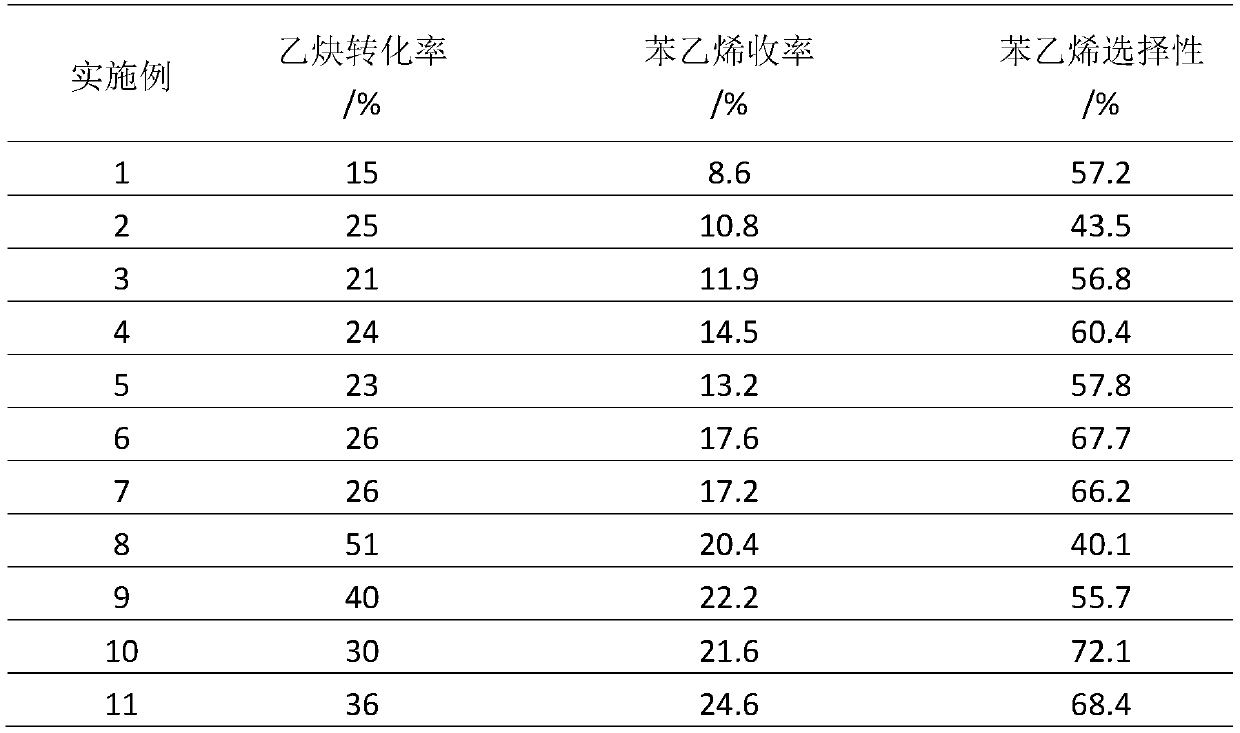Catalyst for catalyzing acetylene to directly prepare styrene, and preparation method and application thereof
A catalyst, styrene technology, applied in physical/chemical process catalysts, molecular sieve catalysts, chemical instruments and methods, etc., can solve the problems of low industrial profits and overcapacity of polyvinyl chloride, achieve short process routes, widen production capacity, The effect of obvious technical advantages
- Summary
- Abstract
- Description
- Claims
- Application Information
AI Technical Summary
Problems solved by technology
Method used
Image
Examples
Embodiment 1
[0044] (1) Catalyst preparation
[0045] Catalyst component silicon / ZSM-5 molecular sieve mass ratio = 5:95. Select a molecular sieve with a silicon-aluminum ratio of 150 for thermal activation roasting treatment, the roasting temperature is 500 ° C, and the roasting time is 8 hours; then weigh 3.71 g of tetraethyl orthosilicate, and 9.5 g of the activated molecular sieve; drop ethyl orthosilicate Add 11.4mL of n-hexane and stir to form a uniform precursor solution; drop the precursor solution into molecular sieves for impregnation, and perform ultrasonic treatment for 2 hours after the addition; after ultrasonic treatment, heat and evaporate to remove the dispersant, heating temperature 100 ° C, The evaporation time is 2 hours; finally, roasting is carried out at a roasting temperature of 350° C. and a roasting time of 5 hours to obtain a finished catalyst, which is granulated and sieved to 40-60 meshes for later use.
[0046] (2) Catalyst evaluation
[0047] A fixed-bed mi...
Embodiment 2
[0049] (1) Catalyst preparation
[0050] Catalyst component silicon / ZSM-5 molecular sieve mass ratio = 3:97. Select a molecular sieve with a silicon-aluminum ratio of 150 for thermal activation roasting treatment, the roasting temperature is 600°C, and the roasting time is 6 hours; then weigh 2.22 g of tetraethyl orthosilicate, and 9.7 g of the activated molecular sieve; drop ethyl orthosilicate Add 10.7mL of ethanol and stir to form a uniform precursor solution; drop the precursor solution into molecular sieves for impregnation, and perform ultrasonic treatment for 1 hour after the addition; after ultrasonic treatment, heat and evaporate to remove the dispersant. The time is 3 hours; finally, roasting is carried out at a roasting temperature of 300°C and a roasting time of 4 hours to obtain the finished catalyst, which is granulated and screened to 40-60 meshes for later use.
[0051] (2) Catalyst evaluation, with embodiment 1 evaluation condition, evaluation result sees tab...
Embodiment 3
[0053] (1) Catalyst preparation
[0054] Catalyst component silicon / ZSM-5 molecular sieve mass ratio=4:96. Select a molecular sieve with a silicon-aluminum ratio of 150 for thermal activation roasting treatment, the roasting temperature is 550 ° C, and the roasting time is 7 hours; then weigh 2.97 g of tetraethyl orthosilicate, and 9.6 g of activated molecular sieve; add ethyl orthosilicate dropwise Stir in 11mL of n-hexane to form a uniform precursor solution; drop the precursor solution into molecular sieves for impregnation, and perform ultrasonic treatment for 3 hours after the addition; after ultrasonic treatment, heat and evaporate to remove the dispersant, heating temperature 90°C, evaporate The time is 2 hours; finally, calcination is carried out, the calcination temperature is 350°C, and the calcination time is 4 hours to obtain the finished catalyst, which is granulated and sieved to 40-60 meshes for later use.
[0055] (2) Catalyst evaluation, with embodiment 1 eva...
PUM
 Login to View More
Login to View More Abstract
Description
Claims
Application Information
 Login to View More
Login to View More - R&D
- Intellectual Property
- Life Sciences
- Materials
- Tech Scout
- Unparalleled Data Quality
- Higher Quality Content
- 60% Fewer Hallucinations
Browse by: Latest US Patents, China's latest patents, Technical Efficacy Thesaurus, Application Domain, Technology Topic, Popular Technical Reports.
© 2025 PatSnap. All rights reserved.Legal|Privacy policy|Modern Slavery Act Transparency Statement|Sitemap|About US| Contact US: help@patsnap.com

